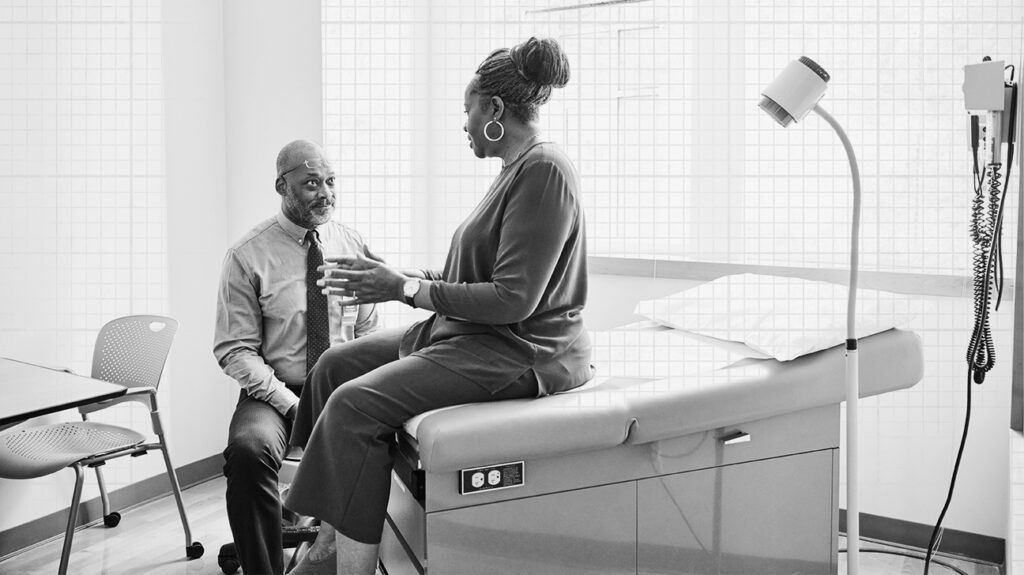An ultrasound scan can help a doctor identify abnormal areas in the breast that may suggest cancer. However, other diagnostic processes are typically necessary to diagnose malignant breast cancer.
A doctor may use ultrasound imaging to examine abnormal areas in the breast that may suggest cancer, such as masses with irregular shapes or uneven margins, or areas that look different from the surrounding breast tissue.
They may use ultrasound imaging as part of an initial evaluation or after diagnosis to guide treatment. However, ultrasound alone cannot confirm that a tumor is malignant — a biopsy is necessary for a definitive diagnosis.
This article explains what to know about ultrasound imaging and malignant breast cancer.

Doctors may use ultrasound imaging at various stages of breast cancer diagnosis and management.
For example, it can be an additional part of breast cancer screening with mammography, especially in people with dense breast tissue where mammograms are less effective. If a mammogram detects an abnormality, an ultrasound can provide additional details.
If an abnormal area needs a biopsy to check for cancer, a radiologist can use an ultrasound to help find the area of concern.
Ultrasound can reveal characteristics of a lesion that suggest malignancy, such as:
- shape
- margins
- composition (whether it is solid or filled with fluid)
These features can help radiologists identify suspicious lesions that may require further investigation.
However, while an ultrasound can strongly suggest the presence of cancer based on the appearance of a lesion, it cannot definitively diagnose cancer or determine its stage.
Other necessary techniques
Staging cancer
According to the
- a physical examination and medical history
- additional imaging tests, such as:
- biopsy, which involves a doctor removing a sample of the suspicious area to examine in a lab
The ACS states that a biopsy is the only way for a healthcare professional to know for certain whether someone has breast cancer.
An ultrasound is a useful diagnostic tool for evaluating breast lesions. It allows doctors to observe certain features that suggest whether a tumor is likely benign or malignant.
However, it is important to remember that ultrasound findings require confirmation with a biopsy, which is
Below are some features a doctor may look for with an ultrasound:
| Feature | Malignant | Benign |
|---|---|---|
| shape | usually oval or round | |
| margins | usually irregular and not well-defined, may be spiky | often well-defined and smooth |
| echogenicity | may have homogeneous (of the same kind) internal echoes because they comprise similar tissue types | |
| typically hard | typically soft and less stiff | |
| often taller than wide | may be wider than tall |
After finding suspicious signs of breast cancer on an ultrasound, the diagnostic process may involve several more steps before moving on to treatment. These may vary depending on the findings, the affected person’s risk factors, and clinical guidelines.
The most critical next step is usually a biopsy to obtain a sample of the suspicious tissue for microscopic examination. The type of biopsy
Doctors may use imaging techniques, including ultrasound, during a biopsy to guide the needle to the correct tissue.
If a needle biopsy does not provide clear results, a doctor may need to perform a surgical biopsy or an open biopsy.
Other steps after an ultrasound may include:
- additional imaging tests
- genetic testing and risk assessment
- staging
- treatment planning
Learn what to expect from breast cancer biopsy recovery.
Breast cancer treatment
A breast cancer treatment plan may include:
- surgery,
such as a lumpectomy or total mastectomy, which involves completely removing one or both breasts - radiation therapy
- chemotherapy
- hormone therapy
- immunotherapy
- targeted therapy
Learn about the different types of breast cancer surgery.
Choosing the right treatment
Treatment choice is highly personalized and often involves a combination of the above options. Doctors
- the characteristics of the cancer, such as hormone receptor status and HER2 status
- cancer stage
- growth speed
- spread of the cancer
- a person’s menopause status
- a person’s overall health and personal preferences
A multidisciplinary team of medical professionals, including oncologists, surgeons, radiation therapists, and others,
This team approach can help address the person’s physical, emotional, and psychological needs throughout their cancer journey.
While ultrasound can identify suspicious areas and provide valuable information about breast lumps, it cannot alone reveal whether breast cancer is malignant.
Further diagnostic procedures, including biopsy and possibly additional imaging tests, are necessary for a definitive diagnosis.
People who have had an ultrasound to investigate potential breast cancer can speak with their doctor about the next steps in their diagnosis.
